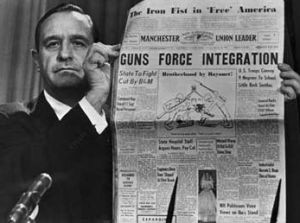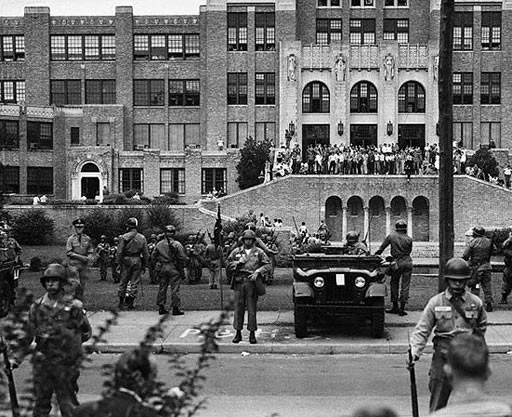Little Rock Central High School
Introduction
Text-to-speech Audio
Images

Orval Faubus holds up a local newspaper that interpretted Eisenhower's actions to enforce the decision of the Supreme Court and uphold integration as tyranny

Soldiers stand guard to enforce the law at Little Rock High School, September 26, 1957

Backstory and Context
Text-to-speech Audio
In 1954, the United States Supreme Court declared public segregation unconstitutional in Brown v. Board of Education. This Supreme Court Ruling made it necessary for all public schools throughout the country to desegregate the school districts 'with all deliberate speed'. Some schools developed strategies to resists integration of the public school system, but school officials at Little Rock, Arkansas stated that they would comply with the Supreme Court's ruling against segregation. The Little Rock district implemented a system where Black students who wanted to attend the white school were put through a series of tests to find out if they were suitable to attend the white school. Of the eighty children that were tested, only nine where given admittance. The student selected were Melba Patillo Beals, Elizabeth Eckford, Ernest Green, Gloria Ray Karlmark, Carlotta Walls Lanier, Terrance Roberts, Jefferson Thomas, Minnijean Brown Trickey, and Thelma Mothershed Wair. These individuals would later be known as the 'Little Rock Nine.'
On September 3, 1957 the nine children arrived at Central High School. Instead of being welcomed with open arms they were greeted by an angry mob of white students, parents, and citizens hell-bent on stopping integration. In addition to the threats, screams, and racial slurs from the crowd, Arkansas Governor Orval M. Faubus stepped in and ordered the Arkansas National Guard to keep the nine Black students from entering the school. The nine students were forced to give up their attempt to attend Central High School. On September 20, 1957, Federal Judge Ronald Davies ordered Governor Faubus to remove the National Guard from Central High School, and to allow the nine Black children admittance. Faubus ignored the order causing President Dwight Eisenhower to send 1,000 paratroopers to the school. On September 23, 1957, the nine Black children returned to the school, and were protected by the United States Army for the entirety of the school year.
